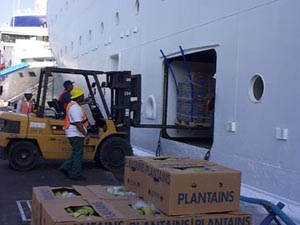Provisioning (cruise ship)
Provisioning (Cruise Ship) refers to the process of supplying a cruise ship with the necessary goods, food, beverages, fuel, and other essentials required for its voyage. This complex operation involves meticulous planning and coordination to ensure that the needs of passengers and crew are met throughout the journey. Provisioning is a critical aspect of cruise ship operations, impacting both the quality of the onboard experience and the vessel's operational efficiency.
Overview[edit | edit source]
Cruise ships are akin to floating hotels, offering a wide range of amenities and services to passengers. To maintain these services, a cruise ship must be well-stocked with a variety of items, from fresh produce and meats to linens and toiletries. The provisioning process begins long before the ship sets sail, with the assessment of needs based on the duration of the voyage, the number of passengers and crew, and the planned activities onboard.
Key Components of Provisioning[edit | edit source]
Food and Beverage[edit | edit source]
The food and beverage component is the most substantial part of cruise ship provisioning. This includes everything from basic ingredients used in meal preparation to luxury items and alcoholic beverages. Special attention is given to sourcing fresh and high-quality products to ensure a wide variety of dining options.
Fuel and Energy[edit | edit source]
Fuel provisioning is crucial for the operation of the cruise ship, as it powers not only the propulsion system but also the onboard generators that supply electricity. Energy efficiency and environmental considerations are increasingly influencing fuel choices.
Operational Supplies[edit | edit source]
This category encompasses items necessary for the daily operations of the ship, such as cleaning supplies, office supplies, and maintenance tools. Safety equipment is also included, ensuring compliance with international safety standards.
Amenities and Leisure Items[edit | edit source]
To enhance the passenger experience, cruise ships offer an array of amenities and leisure activities. Provisioning in this context includes everything from spa products to sports equipment and entertainment materials.
Challenges in Cruise Ship Provisioning[edit | edit source]
Provisioning a cruise ship involves several challenges, including logistical coordination, storage limitations, and waste management. Ensuring the timely arrival of supplies, especially in foreign ports, requires precise scheduling and reliable suppliers. Storage space on a cruise ship is finite, necessitating efficient use of available space and careful inventory management. Additionally, minimizing waste and managing garbage are critical concerns, given environmental regulations and the desire for sustainable operations.
Environmental Considerations[edit | edit source]
The environmental impact of cruise ship operations has come under scrutiny, and provisioning practices are part of this discussion. Efforts to reduce waste, source sustainably, and minimize the carbon footprint of supply chains are increasingly important. Cruise lines are adopting practices such as bulk purchasing, local sourcing, and focusing on recyclable and biodegradable materials to address these concerns.
Conclusion[edit | edit source]
Provisioning is a vital component of cruise ship operations, ensuring that all necessary goods and supplies are on board to meet the needs of passengers and crew. The process requires careful planning, coordination, and attention to detail to address the unique challenges of supplying a moving vessel. As the cruise industry continues to grow, efficient and sustainable provisioning practices will remain a key focus.
| This article is a stub. You can help WikiMD by registering to expand it. |
Search WikiMD
Ad.Tired of being Overweight? Try W8MD's physician weight loss program.
Semaglutide (Ozempic / Wegovy and Tirzepatide (Mounjaro / Zepbound) available.
Advertise on WikiMD
|
WikiMD's Wellness Encyclopedia |
| Let Food Be Thy Medicine Medicine Thy Food - Hippocrates |
Translate this page: - East Asian
中文,
日本,
한국어,
South Asian
हिन्दी,
தமிழ்,
తెలుగు,
Urdu,
ಕನ್ನಡ,
Southeast Asian
Indonesian,
Vietnamese,
Thai,
မြန်မာဘာသာ,
বাংলা
European
español,
Deutsch,
français,
Greek,
português do Brasil,
polski,
română,
русский,
Nederlands,
norsk,
svenska,
suomi,
Italian
Middle Eastern & African
عربى,
Turkish,
Persian,
Hebrew,
Afrikaans,
isiZulu,
Kiswahili,
Other
Bulgarian,
Hungarian,
Czech,
Swedish,
മലയാളം,
मराठी,
ਪੰਜਾਬੀ,
ગુજરાતી,
Portuguese,
Ukrainian
Medical Disclaimer: WikiMD is not a substitute for professional medical advice. The information on WikiMD is provided as an information resource only, may be incorrect, outdated or misleading, and is not to be used or relied on for any diagnostic or treatment purposes. Please consult your health care provider before making any healthcare decisions or for guidance about a specific medical condition. WikiMD expressly disclaims responsibility, and shall have no liability, for any damages, loss, injury, or liability whatsoever suffered as a result of your reliance on the information contained in this site. By visiting this site you agree to the foregoing terms and conditions, which may from time to time be changed or supplemented by WikiMD. If you do not agree to the foregoing terms and conditions, you should not enter or use this site. See full disclaimer.
Credits:Most images are courtesy of Wikimedia commons, and templates Wikipedia, licensed under CC BY SA or similar.
Contributors: Prab R. Tumpati, MD

